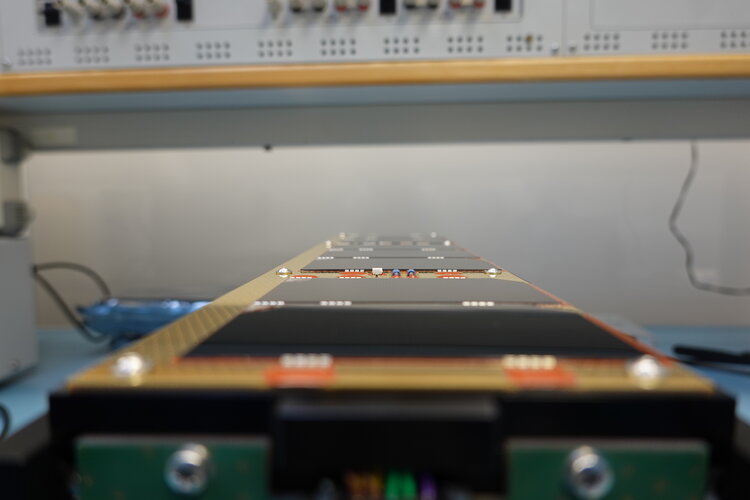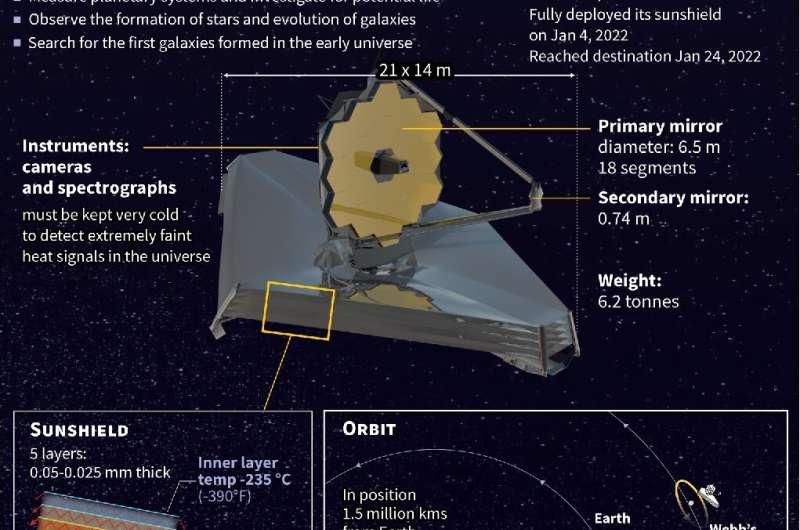NASA Reveals Webb Telescope’s First Images of Unseen Universe
Tuesday, 12 July 2022 11:21 The dawn of a new era in astronomy has begun as the world gets its first look at the full capabilities of NASA’s James Webb Space Telescope, a partnership with ESA (European Space Agency) and CSA (Canadian Space Agency).
The dawn of a new era in astronomy has begun as the world gets its first look at the full capabilities of NASA’s James Webb Space Telescope, a partnership with ESA (European Space Agency) and CSA (Canadian Space Agency). China to target near-Earth object 2020 PN1 for asteroid deflection mission
Tuesday, 12 July 2022 11:12
China has set its sights on near-Earth object 202 PN1 as the target for a combined asteroid deflection and observation test mission due to launch in 2026.
The post China to target near-Earth object 2020 PN1 for asteroid deflection mission appeared first on SpaceNews.
AI CubeSat headed to Van Allen Belts on Vega-C
Tuesday, 12 July 2022 10:58
An ESA-financed nanosatellite, due to lift off aboard the inaugural flight of Vega-C this Wednesday, will operate an AI system in the harsh, radiation-wracked environment of the Van Allen Belts. The shoebox-sized Trisat-R – one of six ‘CubeSats’ on the flight, headed up to a rarely-trafficked close to 6000 km altitude orbit – is also carrying radiation-detection payloads from CERN, the European Council for Nuclear Research, Slovenian firm SkyLabs and ESA itself.
James Webb Telescope to release more breathtaking cosmic views
Tuesday, 12 July 2022 10:40
After unveiling the clearest view yet of the distant cosmos, the James Webb Space Telescope has more to come.
The next wave of images on Tuesday will reveal details about the atmosphere of a faraway gas planet, a "stellar nursery" where stars form, a "quintet" of galaxies locked in a dance of close encounters, and the cloud of gas around a dying star.
They will be published starting from 10:30 am Eastern Time (1430 GMT), in an event live streamed from the NASA Goddard Space Flight Center, just outside Washington.
Targets include Carina Nebula, a stellar nursery, famous for its towering pillars that include "Mystic Mountain," a three-light-year-tall cosmic pinnacle captured in an iconic image by Hubble.
Webb has also carried out a spectroscopy—an analysis of light that reveals detailed information—on a gas giant planet called WASP-96 b, which was discovered in 2014.
Nearly 1,150 light-years from Earth, WASP-96 b is about half the mass of Jupiter and zips around its star in just 3.4 days.
Earth imagery companies reimagine satellite tasking
Tuesday, 12 July 2022 10:35
Earth observation startups and established firms have streamlined satellite tasking.
The post Earth imagery companies reimagine satellite tasking appeared first on SpaceNews.
BlackSky and Esri unveil tasking through ArcGIS Online
Tuesday, 12 July 2022 10:30
BlackSky Technology unveiled satellite tasking July 12 through Esri’s ArcGIS Online geographic mapping platform.
The post BlackSky and Esri unveil tasking through ArcGIS Online appeared first on SpaceNews.
NASA's Webb Telescope Is Now Fully Ready for Science
Tuesday, 12 July 2022 10:21 The months-long process of preparing NASA's James Webb Space Telescope for science is now complete. All of the seventeen ways or 'modes' to operate Webb's scientific instruments have now been checked out, which means that Webb has completed its commissioning activities and is ready to begin full scientific operations.
Each of Webb's four scientific instruments has multiple modes of operati
The months-long process of preparing NASA's James Webb Space Telescope for science is now complete. All of the seventeen ways or 'modes' to operate Webb's scientific instruments have now been checked out, which means that Webb has completed its commissioning activities and is ready to begin full scientific operations.
Each of Webb's four scientific instruments has multiple modes of operati Prospecting for Interstellar Oil
Tuesday, 12 July 2022 10:21 We have developed a new method to look for carbon compounds in space, akin to prospecting for oil on Earth. Between the stars lie vast amounts of interstellar gas and dust, spread thinly throughout our Galaxy.
The dust can contain compounds of carbon. When it does we call it carbonaceous interstellar dust. This is an important reservoir for the organic material in space. The continual cycl
We have developed a new method to look for carbon compounds in space, akin to prospecting for oil on Earth. Between the stars lie vast amounts of interstellar gas and dust, spread thinly throughout our Galaxy.
The dust can contain compounds of carbon. When it does we call it carbonaceous interstellar dust. This is an important reservoir for the organic material in space. The continual cycl The life puzzle: the location of land on a planet can affect its habitability
Tuesday, 12 July 2022 10:21 New climate models have found that the amount and location of land on a planet's surface can significantly impact its habitability. Astronomers have identified substantial differences in surface temperature, sea ice and water vapour across a planet's surface for different land configurations. The work will be presented on Monday 11 July at the National Astronomy Meeting (NAM 2022) by Evelyn Macd
New climate models have found that the amount and location of land on a planet's surface can significantly impact its habitability. Astronomers have identified substantial differences in surface temperature, sea ice and water vapour across a planet's surface for different land configurations. The work will be presented on Monday 11 July at the National Astronomy Meeting (NAM 2022) by Evelyn Macd MIT design for Mars propellant production trucks wins NASA competition
Tuesday, 12 July 2022 10:21 Using the latest technologies currently available, it takes over 25,000 tons of rocket hardware and propellant to land 50 tons of anything on the planet Mars. So, for NASA's first crewed mission to Mars, it will be critical to learn how to harvest the red planet's local resources in order to "live off the land" sustainably.
On June 24, NASA announced that an MIT team received first place i
Using the latest technologies currently available, it takes over 25,000 tons of rocket hardware and propellant to land 50 tons of anything on the planet Mars. So, for NASA's first crewed mission to Mars, it will be critical to learn how to harvest the red planet's local resources in order to "live off the land" sustainably.
On June 24, NASA announced that an MIT team received first place i Advanced Navigation sets sight to be the first Australian company to reach the Moon
Tuesday, 12 July 2022 10:21 Advanced Navigation, one of the world's most determined innovators in AI robotics, and navigation technology has announced its ambitions to be the first Australian company to reach the Moon through its development of two unique navigation systems.
"The team is absolutely thrilled to see years of research in development progress into successful technology. We look forward to being the first
Advanced Navigation, one of the world's most determined innovators in AI robotics, and navigation technology has announced its ambitions to be the first Australian company to reach the Moon through its development of two unique navigation systems.
"The team is absolutely thrilled to see years of research in development progress into successful technology. We look forward to being the first NASA's Perseverance Scouts Mars Sample Return Campaign Landing Sites
Tuesday, 12 July 2022 10:21 The six-wheeled explorer has inspected a stretch of the Red Planet to see if it is flat enough for NASA's next Mars lander.
NASA's Perseverance Mars rover is conducting its science campaign, taking samples at Jezero Crater's ancient river delta, but it's also been busy scouting. The rover is looking for locations where the planned Mars Sample Return (MSR) Campaign can land spacecraft and c
The six-wheeled explorer has inspected a stretch of the Red Planet to see if it is flat enough for NASA's next Mars lander.
NASA's Perseverance Mars rover is conducting its science campaign, taking samples at Jezero Crater's ancient river delta, but it's also been busy scouting. The rover is looking for locations where the planned Mars Sample Return (MSR) Campaign can land spacecraft and c Leaving Avanavero - Sol 3530
Tuesday, 12 July 2022 10:21 The MAHLI images acquired on Sol 3528 confirm that the APXS was well placed over the Avanavero drill tailings, and the APXS data look good so we are ready to drive away from this location.
But first, we are planning a few more MAHLI and remote sensing observations. ChemCam will shoot its laser at a vein target named "Chiung" on the right side of the rover, then will acquire another RMI mos
The MAHLI images acquired on Sol 3528 confirm that the APXS was well placed over the Avanavero drill tailings, and the APXS data look good so we are ready to drive away from this location.
But first, we are planning a few more MAHLI and remote sensing observations. ChemCam will shoot its laser at a vein target named "Chiung" on the right side of the rover, then will acquire another RMI mos New Findings on the Formation of Ionized Carbon
Tuesday, 12 July 2022 10:21 Scientists have long held that star formation creates ionized carbon giving vital information for understanding our universe. But a new study led by Universities Space Research Association's Robert Minchin, has shown that ionized carbon is also formed by galaxies moving through the hot gas of the Virgo cluster.
Since the 1990's scientists have suspected that ionized carbon might be formed
Scientists have long held that star formation creates ionized carbon giving vital information for understanding our universe. But a new study led by Universities Space Research Association's Robert Minchin, has shown that ionized carbon is also formed by galaxies moving through the hot gas of the Virgo cluster.
Since the 1990's scientists have suspected that ionized carbon might be formed Black Hole Hunters - A citizen science search for black hole self-lensing
Tuesday, 12 July 2022 10:21 A research team from the Open University and the University of Southampton is asking for the public's help to find some of the most mysterious, elusive objects in the Universe - black holes. By examining data from the SuperWASP survey, the UK's leading extra-solar planet detection programme, the team hope to detect changes in starlight that may provide evidence for the existence of these black h
A research team from the Open University and the University of Southampton is asking for the public's help to find some of the most mysterious, elusive objects in the Universe - black holes. By examining data from the SuperWASP survey, the UK's leading extra-solar planet detection programme, the team hope to detect changes in starlight that may provide evidence for the existence of these black h 
